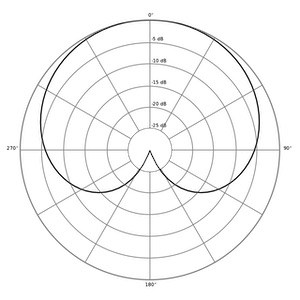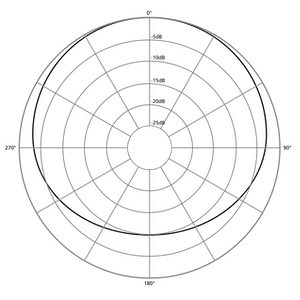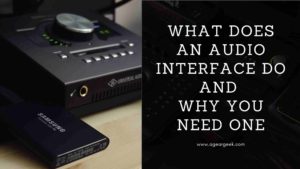Microphones are essential to produce great quality recordings. There are different types of microphones for different usages. In this article we will cover everything about different types of microphones and their usages.
Lets us first understand a few common terms used for microphones.
Disclosure: We’re an affiliate. We hope you love the products we recommend! This post contains affiliate links. If you use these links to buy the products, we may earn a commission from the qualified sales. These are at no additional cost to you. Thank you if you use our links, we really appreciate it!
What are Transducers?
Microphones are a kind of transducer. In simple words, a transducer is a device that converts energy from one form to another. In the case of microphones, they convert the sound waves (mechanical energy) to electrical energy
What are polar patterns?
Polar Patters are essentially the inherent directionality of the microphones. In simple terms, it means the sensitivity of the microphones to capture sound frequencies from specific directions. The polar pattern thus reflects the variation in sensitivity of a microphone on a 360 curve.
This is an important factor in sound recording. Adjusting the polar pattern reduces unwanted sound sources to bleed into your recording.
How to read a polar pattern graph?
The Polar Patters are plotted on a 360 Deg graph. In the graphs, 0 Deg is the front of the microphone and 180 Deg is the back. Polar pattern graphs can show the sensitivity of the microphone from all angles. This helps in deciding to choose for specific uses.
There are 3 main polar patterns and some other variations
The three main polar patterns are Cardioid, Figure of 8, and Omnidirectional. The other patterns mentioned below are improvisations on these basic three.
Cardioid or Unidirectional

This is the most common of all the polar patterns. Here the sensitivity of the microphone is maxed at the front (at 0 deg) and least at the back (180 Deg). Cardioid microphones help to capture a dry signal from the front and cancel out background noises.
The cardioid polar pattern is ideal for vocals, podcasting, live performances where strong signals from a single direction need to be prioritized and at the same time reducing any backgrounds. These are equally good for instruments like drums, guitar, or wind instruments. These are by far has the most applicability among all the different patterns.
Supercadioid Pattern

This pattern is a further modification of the cardioid pattern. In the Supercardioid mode, the front and the sides of the microphone get more signal than a cardioid pattern. But unlike the cardioid pattern, the back gets comparative less rejection. These are very good for vocals and especially for live situations where it provides high gain before feedback.
Omnidirectional Patterns

The Omnidirectional pattern provides an equal sensitivity from all directions. Since these types of microphones provide a uniform sensitivity all around, they lack back rejections. These are best not used in loud environments and rooms which have poor acoustics. If placed close to the PA systems can cause issues with feedback.
Figure 8 Pattern

This pattern provides the same sensitivity at the front ( 0 Deg) and also at the back (180 Deg). Figure 8 pattern has the maximum rejection from the sides at 90 Deg and 270 Deg.
Figure 8 becomes very useful in an environment where you do not want sound signals from the side to bleed into your microphone. These have the highest side rejections compared to any other pattern.
These are great for interviews. The same microphone can capture the signals of both the interviewer and the interviewee. Can be a great tool in the hands of a podcaster who also takes in-person interviews.
Wide Cardioid

This a mix of cardioid and Omni and has features of both of them. These have a wider sensitivity than a cardioid but not to the effect of having uniform sensitivity like an Omni. This pattern is best suited for recording a group of instruments together which needs a wider coverage. A great option to record a string quartet.
Shotgun

A shotgun microphone is perhaps the most extreme among the directional patterns. It has a very narrow sensitivity at the front and sounds from all other sides are practically rejected. The tightness of the polar pattern is dependent on the length of the tube, the longer the tighter. These are generally used by Vloggers, journalists, in films where sounds are required to be picked up from a distance.
What is Frequency Response
In simple terms, frequency response means the range of frequencies a microphone can capture and reproduce. For example, the audible frequency range for the human ear is 20 Hz to 20 kHz. In some individuals, this can vary depending on age and other factors.
Similarly, microphones that have an equal response across all frequencies are called “flat frequency response” while those which peaks or dips at certain frequencies are called “shaped response”.
Shaped frequency response can shape the presence of vocals or increase the bass response of drums etc. There are certain types of microphones that have switchable shaped frequency response modes like Shure SM7B.
What are On-Axis and Off-Axis
The 0 Deg point which we were referring to above is also known as the “On Axis” point. So naturally, sound sources from all other directions become a varied degree of Off-Axis.
What is Proximity Effect
In this phenomenon, there is an increase in the bass response as the microphone is moved closer to the source. The proximity effect happens when the microphone gets closer to the source, it translates to a bigger bass boost.
It can be a friend and a foe depending on the scenario. While it can make a voice sound big and deep, but at the same time can get muddy. This especially happens when combined with bass and drums.
Proximity effects are strongest in Figure 8 patterns followed by Cardioid. Omnidirectional pattern microphones hardly have any proximity effect. This is due to the pressure gradient principle.
What is Pressure Gradient
Microphones where both sides of the diaphragm are exposed to sound waves become responsive to the sound pressure differential (Pressure Gradient) between the two diaphragms. This causes the proximity effect.
The omnidirectional pattern in a multi-pattern microphone is created by two equal cardioid patterns on both sides. This as a result sums up the signals of both the diaphragms and hence does not lead to a pressure differential (gradient). Thus omnidirectional mics are not responsive to Proximity Effect.
What is Gain before Feedback
In simple terms, this means the amount of gain you are able to apply to a microphone before it starts to feedback from the monitors and PA systems. This phenomenon is dependent on the mic, the placement of the microphone, and its proximity to the PA systems.
Understanding Diaphragm – What is a Diaphragm of a microphone?
The diaphragm is a thin piece of material, often mylar or some form of metal. When sound strikes the diaphragm, it causes it to vibrate and this passes energy through the rest of the microphones’ s components.
These vibrations are converted to electrical current. These then become the audio signal for your interface to capture and playback sound.
Diaphragms are very thin material and this extremely thin nature makes them sensitive to minute sound frequencies. The mass of the diaphragm has an impact on the sound. A lighter one yields a higher frequency response.
Top Address Microphones
In these microphones, the diaphragm faces the top of the microphone. These types of microphones are generally cardioid pattern or omnidirectional pattern mics as the bi-directional pattern has practical challenges to create without both the diaphragms being evenly exposed.
Side Address Microphones
As the name suggests the side-address microphones have the diaphragms pointed towards the sides. In this kind of microphone, it is possible to have all the three patterns of cardioid, Figure 8, or omnidirectional. The diaphragms of these types of microphones are evenly exposed.
There are three main types of diaphragm which are moving coil, ribbon, and condenser.
Moving Coil: These are found in dynamic microphones and are made up of two separate parts – the diaphragm and the moving coil. These have lower sensitivity for high frequency and are less sensitive compared to Condenser and Ribbons.
Ribbon: Ribbon diaphragms are mostly corrugated rather than thin and are large in size. These diaphragms are extremely thin and are very fragile and are not suitable for high impact sounds like Drums etc. These are extremely sensitive and provide an accurate response.
Condenser: The diaphragm of condensers are made of metal or gold plated mylar. There are two kinds of condenser diaphragms – Small Diaphragm and Large Diaphragm.
Small Diaphragm Condensers (SDCs): These are also called the pencil microphones and are top address microphone types. The SDCs are great for high-frequency responses and brighter instruments. The microphone capsule being smaller also provides a more consistent polar response. These are great for acoustic guitars and percussions.
Large Diaphragm Condensers (LDCs): These are mostly sides address microphones. This enables these microphones to have switchable polar patterns with a dual case diaphragm. These can have all three polar patterns in a single microphone.
The mass of the diaphragm increases with the size of the diaphragm and enables more displacement of air and better signal. These are great for vocals to capture the nuances of the lows and the mids.
Types of Microphones
There are primarily three types of microphones – Dynamic, Condenser and Ribbon Microphones.
Dynamic Microphones
Dynamic microphones are less sensitive than condenser and ribbon microphones. These microphones are also a lot sturdier than the other types. Dynamic Mics are generally less expensive than the Condenser and the Ribbon varieties.
Dynamic microphones do not require any external power for the mic to operate. They are Passive in nature. The microphone’s internal magnet is able to drive the power for the microphone to work.
These microphones work great for drums and loud sounds and are able to withstand loud SPL. Dynamic microphones also work great in quieter surroundings and are perfectly fine for vocals as well. They are a great choice to be used in Live settings.
Condenser Microphones
Condenser microphones on the other hand are much more sensitive than a dynamic microphone. Unlike Dynamic microphones, condensers are not passive and they need power for their internal circuit to work.
The additional power of the condenser microphones is delivered through Phantom Power from the audio interfaces. Phantom Power is denoted by the 48v switch on your audio interface.
Large Diaphragm Condenser microphones can have switchable polar pattern on the same mic. These microphones are great for vocals or where you need more sensitivity towards lows and mids.
Small Diaphragm Condensers are great for micing guitars, snare, hi-hats, etc.
Condenser microphones tend to be more on the premium side and good microphones can cost a few thousand dollars.
Ribbon Microphones
These are the oldest out of the three and was originally used by the Radio. Now they are making a come back.
Ribbon microphones are expensive and at the same time, they are fragile. The diaphragm of the ribbon microphones are very thin, long, and sensitive. This makes them susceptible to damage at high SPL or wind situations.
It is also recommended not to store a ribbon mic horizontally as the Ribbon inside can sag and permanently damage it. These need to be handled with care and any drop or fall of these mics can damage the diaphragm setting you back by a few hundred dollars just to replace it.
Ribbon microphones are very sensitive microphones and are primarily used for vintage sounds with low bass. These are great for vintage vocals and wind instruments and gives a very warm and natural tone which the classic sounds represent.
Ribbon microphones are very pre amp dependent. These microphones need specific grade preamps to deliver the power for the microphone to work. Some Ribbon microphones have inbuilt preamp and thus can be powered by the standard Phantom Power of your audio interface. Unless specified to be compatible, Phantom Power should not be used on a Ribbon mic, as it can damage it.
Applicability of Microphones
Vocals: For vocals, you can use all three – Dynamic, Condenser, or Ribbon Mic. The best polar pattern to choose for vocals is Cardioid Pattern so that the microphone can get a dry signal from the front and reject the other background sounds. Ribbons will definitely give a more warm and natural sound, more suitable if you are trying to achieve a classic sound than perhaps Heavy Metal vocals.
Some good recommendations for vocals are Shure SM 7B as a Dynamic, Audio Technica AT 4040 as an LDC, and Audio Technica AT 4081 for ribbon.
No products found.
No products found.
No products found.
Podcasting; Again, Podcasting will be very similar to vocals where mostly you will have individual people speaking to the microphones. In such a setup both a Dynamic or Condenser Cardioid Set up works fine. If you also plan to have in-person interviews in your studio, then perhaps having a Large Diaphragm Condenser Microphone with a Figure 8 Pattern is good.
Shure SM58 is a great choice of a dynamic microphone for podcasting. This is a top access cardioid pattern which is perfect for such a setup. For Interviews AT 4050 multipattern microphone should work perfect.
No products found.
No products found.
Acoustic Guitars and Percussions: Acoustic guitars have a brighter tone and Small Diaphragm Condensers will work the best. Shure SM81 can be the perfect choice for these instruments. These mics are fast and have a great sensitivity to high frequencies. Shure SM57 is also a great choice among Dynamic Microphones.
If you want to use Large Diaphragm Condensers then Shure KSM44A or Warm Audio WA-87 are some brilliant options.
No products found.
No products found.
Kick Bass: The best option for a kick bass is AKG D112. This is a Large Diaphragm Condenser where the frequency response is tailored for kick drums and bass cabs.
No products found.
Snare Drums: Again the Shure SM57 is a great option for Snare drums. Other great options are SE Electronics V7 and Telefunken M80.
No products found.
No products found.
Hi-Hat & Cymbals: You will be good with a Small Diaphragm Condenser here. Good options are Neumann KM184 or the Shure SM81-LC
No products found.
No products found.
Tom: For Toms, the best to have is Sennheiser MD 421 or MD 441U. It might be a bit pricey but trust me this is what you would need.
No products found.
No products found.
Drum Mic Bundles: You can also go for a drum mic bundle that can have all the mics which you would need. Here are two such great options. Sennheiser e600 & Audix DP 7/
No products found.
No products found.
Electric Guitars: The Shure SM57 can be a great option for this as well. A very versatile microphone indeed. Other options are Sennheiser MD421 Sennheiser e609.
No products found.
Piano: The MXL Mics 770 is a great choice for recording piano and it comes in a well affordable range. It has a balanced low-frequency response along with clear highs making it a good choice for keys. The other option could be Rode NT5 – MP.
No products found.
No products found.
Wind Instruments: Shure has some great options including the very versatile SM 57 but if you are willing to pay a little extra, you can get a fantastic model S 137. Unlike the SM57 which is a dynamic microphone, the SM 137 is a Small Diaphragm Condenser with exceptional natural-sounding reproduction.
No products found.
Conclusion
I hope this article has given you a little more information on the types of microphones and which ones to choose for your style or instrument.
Microphones are very important equipment, which can make or ruin your sound if the right one is not used. Do your research on the types of microphone and choose the one which fits both – your budget and sound.
A word of advice, you can never have enough microphones. At any given point in time, you will give enough reasons to give yourself to get a new one – this is from the experience of being a gear geek.
Last update on 2024-05-07 / Affiliate links / Images from Amazon Product Advertising API






Pingback: Building a Home Studio on a Budget - Beginners Guide - A Gear Geek
Pingback: What equipment do singers & songwriters need? - A Gear Geek